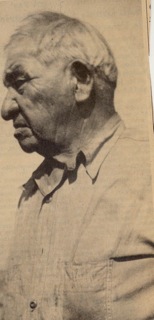New old story by June Morrall (This is actually the last part of a series I wrote int he 1970s.)
 Andres Osorio: Did the last Costanoan live and die in Half Moon Bay?
Andres Osorio: Did the last Costanoan live and die in Half Moon Bay?
On the heels of Spanish exploration, the Indians at Half Moon Bay faced a crisis threatening their very existence–and lost.
Within half a century, a chain of missions, staffed with padres, stretched from Sonoma to San Diego.. The Costanoan religion, based on sun worship [the Indians moved from the warmer Peninsula to the Coastside at certain times of the year, probably when they could gather certain foods, and back again]brought only disapproving glances from their new masters who sought to convert them to Christianity. Coastanoan life, as it had been known, suffered a complete and irreversible uprooting.
It all began innocently enough with peaceful visits to neighboring tribes always accompanied by a corporal’s guard of Spanish soldiers. On these occasions, the missionaries used the art of persuasion to endorse the new religion. The response was not always encouraging.
But glowing reports promising an abundant life at the mission, including samples of succotash and other taste-delights, reinforced their efforts. If all else failed, the Spanish soldiers, with their “strange” firearms, alarmed the comparatively naive Indians into submission–remember, their simple weapons consisted of the bow and arrow.
At every opportunity along the way, the padres performed baptisms. They dipped into the “Old Testament,” replacing original, native names with new Christian ones. At San Gregorio, Chief Isuu was christened Juan de los Santos. When the reservoir of names ran out, practically everybody else was called “Jose.”
And despite strict regulations forbidding missionaries to spend even one night in an Indian village, their methods produced results. It didn’t take long before the padres performed a Christian burial at the village called “Shalaihme” on Purisima Creek.
Overnight entire tribelets converted to the new religion, and native villages dissolved.
By 1790, all of Half Moon Bay’s Indians experienced the process of conversion. Most were taken to the San Francisco Mission Outpost in the San Pedro Valley, and the present day site of Pacifica’s historic Sanchez Adobe.
Chief Lachigi, along with 30 of his followers, from the village of “Zucigim” at San Gregorio, joined the mushrooming numbers of converts at the outpost.
Here they learned to adapt to a new lifestyle, working as laborers (talented masons, carpenters, vaqueros, tailors, blacksmiths, seamstresses, woodcutters) at the mission.
French navigator, La Perouse, after encountering the mission system, observed that the missionaries were enslaving the Indians in this life, to save them in the next.
As Mission Dolores in San Francisco grew crowded, the mission system reached as far south as Tunitas Creek.
Four or five miles north of Purisima Creek in Half Moon Bay, the Corral de Tierra, a mission ranch, existed at the headland called Pillar Point. On this range, thousands of branded cattle and horses often ran wild into the mountains. At round-up time, east of the Medio Creek in Miramar, the Indian vaqueros herded them into two corrals, one described in the San Mateo County History Museum’s archives as 500 feet in diameter, the other 300 feet.
South of Pilarcitos Creek, a mission rancho called “El Pilar” operated in the same manner. Although all traces vanished of its existence, there may have been another village south of Half Moon Bay at Canada Verde Creek.
Indian herdsmen drove the stock out of Half Moon Bay via two mountains trails north toward San Francisco. One trail closely followed present-day Highway 1, over Pedro Mountain, then called “Santa Clara Mountain” by the missionaries and “Las Auras,” or “the vultures,” by still others. The second trail, located on a steep grade to the north of present day San Mateo Road, probably was more commonly used.
During “pasear,” or “walkabout,” the Indians were allowed temporary freedom to return to their native land during “the season of ripe seeds.” Many took this opportunity as a convenient time to escape their masters, their destination mountain hideaways in the Santa Cruz Mountains, where some emerged as outlaws.
From the relative safety of secluded mountain caves, the Indian outlaws swooped down on the Spanish missions, raiding the ranches and causing chaos.
Some were successful, others quickly apprehended, and brought back to the mission.
In 1789, a military expedition from the San Francisco Presidio searched for runaway Indians on the Coastside. If and when caught, punishment took the form of starvation, whippings or time locked in stocks or irons.
But worse still, the physical contact between the Europeans and Indians produced illnesses the Indians were not immune to–including measles, mumps, small pox, and etc. They died in large numbers. one epidemic alone wiping out one- third of the Indian population at the San Francisco mission.
Sometime in 1806 a startling announcement was made: There were no local Indian guides to accompany a group of travelers wishing to visit the coastal mountain range.
Sixteen yeas later, eleven of the original Coastside natives remained alive, not including descendants.
In 1946, Andre Osorio, Half Moon Bay’s last Indian died. Although he may not have been Costanoan, Osorio, born in Woodside, was carried to Half Moon Bay by his mother on horseback.
Legend has it that when Osorio was a young man, he traveled the United States with his father as a tight rope performer. When he tired of show business, he settled down in Half Moon Bay as a fisherman and farmer. He was one of the first men to grow artichokes for William De Benedetti on a farm north of Half Moon Bay.
When Andres Osorio died in 1946, he claimed to have been born in 1832, making him an incredible 114 years old, and securing him the reputation as Half Moon Bay’s last Indian.
———-
A new-old story by June Morrall
